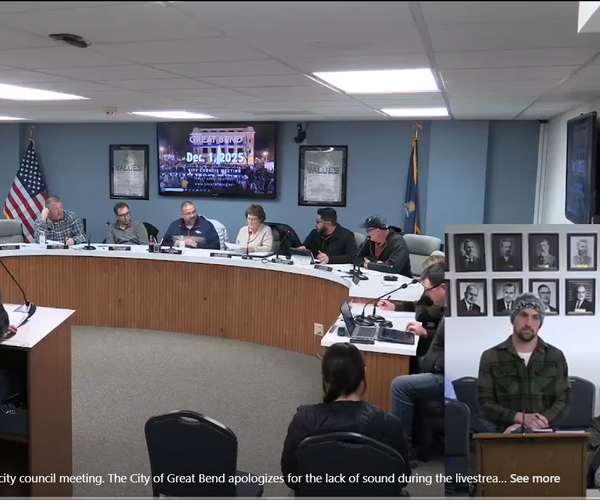A lot has happened this past week. The president kicked off his return to the campaign trail on Saturday, June 20 in Tulsa, Okla. When the original Friday, June 19, date and location was announced, it was noted it fell on Juneteenth, a celebration of when the black slaves in Texas learned they were free. The location for the event was also full of meaning, as the city approaches the 100th anniversary of the Tulsa Race Riot, which occurred there in 1921. In light of current events, an outpouring of posts across social media indicated few had ever learned of this awful part of American history.
But, newspapers from that era provide valuable insight. This week, we return to our Sept. 12, 2013 Morgue column, and we also take a look at how the riot (or massacre, if you prefer) in Tulsa was reported in the Great Bend Tribune back on June 1, 1921.
We encourage readers who want to dig deeper to look at newspaper archives of the early 1920s for more first-hand accounts of this awful period of American history. Also, if you get a chance, visit Tulsa, Okla.,which has an amazing history, a wealth of museums and is an all around eye-opening city. Also, visit the website of the Tulsa Historical Society and Museum (https://www.tulsahistory.org/exhibit/1921-tulsa-race-massacre/#flexible-content).
Background
In 1920, the Tyler family of Atlanta, headed by Mary Elizabeth “Bessie” Tyler, a former madam, and Atlanta publicist, Edward Clarke, turned a stagnant 3,000 member Ku Klux Klan organization, and in three years built it into the Southern Publicity Association, with 3 million members nationwide, and in the process became rich by pocketing a percentage of all membership dues and profits from the sales of robes and hoods.
The KKK became politically powerful, especially in Oklahoma — so much so, then Oklahoma Governor Walton went to extreme lengths to try to corral the Klan within his state. For those who can stomach a chilling tail, read about “Beno Hall: Tulsa’s Den of Terror” at This Land Press (https://thislandpress.com/2011/09/03/beno-hall-tulsas-den-of-terror/ ). Essentially, Klan activities had gotten out of hand, and that’s putting it exceedingly mildly. Walton was a little out of his league, it appears. He suspended the Writ of Habeas Corpus when three Klan members who admitted to a brutal flogging were arrested, which was against the Oklahoma constitution, and he ended up being impeached over it. That being said, he tried to rein in the Klan.
“Preparing for a Finish Fight,” which ran in the Tribune on Sept. 21, 1923, reported Oklahoma legislators intended to seek Governor Walton’s impeachment. They planned to convene that day at noon to consider charges that Walton, “set at naught the constitutional government.” They warned if he tried to interfere, he would at his own peril.
The paper also reported on the “sensational testimony exposing the alleged inner workings of the Ku Klux Klan in Oklahoma City and designed to show that their secret organization has directed mob violence,” which was made public the night before by the Governor.
In the testimony, the Governor appealed to readers for financial assistance for his fight, as it had fallen upon himself and his counselor, Aldrich Blake, to continue the fight against the Klan.
“Every effort is being made to cripple us financially so that we cannot continue the fight. I call upon the people who believe in a representative form of government immediately to assist us financially and to make all remittances to Mrs. Aldrich Blake, Oklahoma City... So far as I am concerned, I have crossed the Rubicon and it is a fight to the finish.
“Jewett (N. C. Jewett, grand dragon of the Oklahoma realm of the Klan) and his crowd have turned the fight over to the Klan newspapers and the Klan members of the legislature.
“Jewett and his ‘invisible empire’ shall not pass in this state.
“If necessary, I shall arm every man in this state who is opposed to his empire.”
The story went on to identify a handful of elected and appointed officials who admitted to membership with the KKK. But ultimately, the story concluded with the sentiment that the reason Walton had declared martial law was in order to keep the legislature from indicting him. Ultimately, less than a month later, he was impeached, and the Lt. Governor was sworn in.
So, how did it get so bad?
Walton, formerly the Oklahoma City Mayor, was Progressive in his politics. While he wasn’t an Oklahoma native, after serving in the Army around the time of the Spanish American War, he had moved there to start a civil engineering practice. He was there before the KKK got its foothold. Perhaps he hadn’t realized how strong they had become.
The June 1, 1921 report in the Great Bend Tribune is biased. According to a 2000 Washington Post report by Lois Romano, it all started when a black teen, Dick Rowland, tripped entering an elevator, and grabbed the arm of a white teen, Sarah Page, to keep from falling. She screamed, and charged him with assault. She later withdrew her charges, but, according to the Washington Post report, the Tulsa Tribune reported Rowland had attacked Page and tore her clothes.
“Within hours of the paper’s publication, more than 1,000 agitated whites reportedly congregated outside the downtown courthouse where Rowland was held in a cell,” according to the Post. “Rumors of a lynching raced through Greenwood ( a Tulsa neighborhood where blacks lived), and armed black men showed up at the courthouse, virtually ensuring a confrontation.”
Tulsa race riot, as reported in the Great Bend Tribune, June 1, 1921
SCORES ARE KILLED IN RACE RIOTING; Assault on White Girl Signal for Race War at Tulsa, Okla.; NEGRO DISTRICT IS IN FLAMES’ Firemen Unable to Check Fires by Fusillade of Shots -- Over 300 Are Injured
“Thirty Negroes and five white men have been killed and more than 300 wounded in the race rioting which broke out last night and which was renewed this morning. Three companies of the National Guard were today called out to assist in quelling the disturbances.
The rioting followed the arrest of a Negro by the name of Dick Rowland charged with assault on a white girl when armed Negroes came to the court house on the upper floor of which Rowland was in jail.
The first killing was that of a Negro who was carrying a gun and making threatening remarks and who resisted arrest, and the crowd which had gathered broke into hardware store and seized firearms to protect themselves against a mob of 200 armed Negroes which had gathered with the avowed intention of wiping out the whites.
Today more than 2,000 Negroes are being guarded by white men in Convention Hall while several hundred more are being guarded in the ballpark. Since the arrival this morning of the National Guard under command of Adjutant General C. F. Barrett the situation is reported as easing but further serious trouble is anticipated.
Two of the dead white men have been identified as F. B. Baker of Haviland, Kansas and Carl D. Letpisch of Randall, Oklahoma.
Rowland, the Negro accused of assault and whose arrest started all the trouble, was during the night removed from the city to a place of safety.
Ten blocks of the Negro residence and business section in South Tulsa are this afternoon in flames and no attempt is being made by the fire department to extinguish the flames. Fire Chief R. C. Adler says that his men made repeated efforts this morning to fight the fire but were driven back by the rioters who shot at them. Motor cars full of armed white men are encircling the Negro district and airplanes are hovering over it.
Many Negro refugees ran from the burning buildings with their hands above their heads crying “don’t shoot,” and were taken to Convention Hall and the ballpark and to jail where they are being cared for by civic organizations. Many of the Negroes were barefoot and in their night clothes. The number of slain this afternoon was estimated to be at least six whites and fifty Negroes, while the list of injured will run into the hundreds.”
Martial Law Announced
On June 1, Oklahoma Governor B. A. Robertson ordered martial law in Tulsa. “A military commission composed of seven city officials and businessmen was appointed to pass upon the status of the 6,000 Negroes who are being held under guard. The fire is still raging in the Negro district but is believed that the white section will escape. A proclamation has been issued ordering all citizens who have not been deputized as special officers to disarm and ordering the arrest of any found with weapons.”
By the following day, Tulsa had quieted. The report of the aftermath ended with these words:
“No accurate check of the dead had been made at a late hour, and unofficial estimates run from the known list of 10 whites and 70 Negroes dead, to an opinion of Police inspector Daley, second in command of the police force, that the list would reach 175 dead.
The exact total, officers said, would probably never be known, as many Negroes perished in the flames, which consumed the entire Negro district which formerly housed about 13,000 Negroes, including women and children.”
Following a Grand Jury investigation, it turned out the mobs rioting were indeed white. Also, according to the Post, “The riot never received particular attention in Tulsa, and in fact, it was barely spoken about for years. A systematic death count was never even made.”





